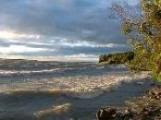Public opinion needed for health of Lake Simcoe
Strong relationships stem from good dialogue.
Having a solid line of communication with Lake Simcoe stakeholders is the key to sustaining a healthy relationship with the lake for generations to come, said Ken Neale, Lake Simcoe Region Conservation Authority spokesperson.
“We need the public to weigh in on these issues and be engaged,” Mr. Neale said.
The province will ask residents and scientists how best to protect Lake Simcoe through a discussion paper, Environment Minister John Gerretsen announced Thursday.
In addition to the paper, news of a scientific advisory committee for the lake and a reduced limit on phosphorus discharge was anounced.
Asking for public input is exactly what Ladies of the Lake co-founder Annabel Slaight says is needed to sustain a healthy watershed.
“People can put in their concerns from their perspective and very many interesting things will come up,” Mrs. Slaight said.
“It’s really 30 years of increasing human activity that has caused the problems. We really need everybody from the farmer to the cottager to a kid to a government official to comment. We live on an ailing lake. We have to do thousands of small actions that will allow the lake to get better,” Mrs. Slaight said.
York-Simcoe MPP Julia Munro said while she supports any move to improve the lake, the Liberals need to provide municipalities with more than ideas, arguing special funding to improve sewer systems should be made available as well.



